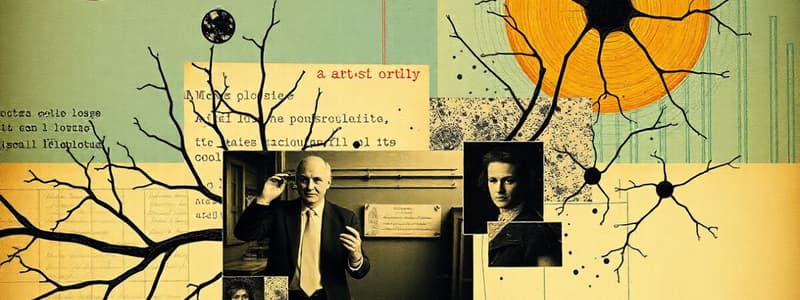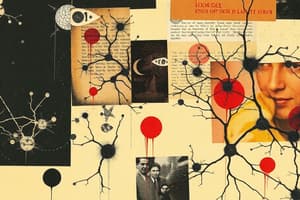Podcast
Questions and Answers
What distinguishes action potentials (APs) from graded potentials like EPSPs and IPSPs?
What distinguishes action potentials (APs) from graded potentials like EPSPs and IPSPs?
- APs are 'all-or-nothing' events with a consistent amplitude, while graded potentials vary in amplitude. (correct)
- APs are dependent on ligand-gated ion channels, while graded potentials depend on voltage-gated ion channels.
- APs vary in amplitude based on the strength of the stimulus, while graded potentials have a fixed amplitude.
- APs are localized to the synapse, while graded potentials travel down the axon.
A neuron's resting membrane potential is -70mV. If an excitatory stimulus causes the membrane potential to reach -55mV at the axon hillock, what will occur?
A neuron's resting membrane potential is -70mV. If an excitatory stimulus causes the membrane potential to reach -55mV at the axon hillock, what will occur?
- Only local graded potentials will be generated, without triggering an action potential.
- The neuron will release inhibitory neurotransmitters into the synapse.
- The neuron will hyperpolarize, inhibiting any further signaling.
- An action potential will be initiated and propagate down the axon. (correct)
An inhibitory postsynaptic potential (IPSP) is MOST likely to result from the:
An inhibitory postsynaptic potential (IPSP) is MOST likely to result from the:
- Efflux of chloride ions out of the postsynaptic neuron.
- Influx of chloride ions into the postsynaptic neuron. (correct)
- Influx of sodium ions into the postsynaptic neuron.
- Blockage of potassium channels in the postsynaptic neuron.
Which of the following is a key difference between voltage-gated Na+ and K+ channels?
Which of the following is a key difference between voltage-gated Na+ and K+ channels?
What is the direct effect of the 'ball and chain' mechanism on a voltage-gated sodium channel?
What is the direct effect of the 'ball and chain' mechanism on a voltage-gated sodium channel?
During the absolute refractory period, it is impossible to trigger a new action potential. This is PRIMARILY because:
During the absolute refractory period, it is impossible to trigger a new action potential. This is PRIMARILY because:
Which of the following BEST describes the state of ion channels during the relative refractory period?
Which of the following BEST describes the state of ion channels during the relative refractory period?
If myelin sheaths were completely removed from a neuron, how would this affect action potential propagation?
If myelin sheaths were completely removed from a neuron, how would this affect action potential propagation?
What is the primary role of the Nodes of Ranvier in myelinated axons?
What is the primary role of the Nodes of Ranvier in myelinated axons?
The diameter of an axon affects the speed of action potential propagation. Which of the following BEST explains why?
The diameter of an axon affects the speed of action potential propagation. Which of the following BEST explains why?
Saltatory conduction is MOST accurately described as:
Saltatory conduction is MOST accurately described as:
How does increasing the frequency of action potentials fired by a neuron typically affect its communication with other neurons?
How does increasing the frequency of action potentials fired by a neuron typically affect its communication with other neurons?
A drug that selectively blocks voltage-gated potassium channels would be expected to:
A drug that selectively blocks voltage-gated potassium channels would be expected to:
A scientist discovers a new neurotoxin that prevents voltage-gated sodium channels from inactivating. What is the MOST likely effect of this toxin on neuronal action potentials?
A scientist discovers a new neurotoxin that prevents voltage-gated sodium channels from inactivating. What is the MOST likely effect of this toxin on neuronal action potentials?
How would the function of a neuron be affected if the sodium-potassium pump stopped working?
How would the function of a neuron be affected if the sodium-potassium pump stopped working?
Flashcards
Action Potential (AP)
Action Potential (AP)
A large, transient change in membrane potential that travels down an axon.
All-or-nothing
All-or-nothing
APs either happen fully or not at all, with no in-between states.
Firing Rate
Firing Rate
The number of action potentials fired per second.
AP Threshold
AP Threshold
Signup and view all the flashcards
EPSP (Excitatory Postsynaptic Potential)
EPSP (Excitatory Postsynaptic Potential)
Signup and view all the flashcards
IPSP (Inhibitory Postsynaptic Potential)
IPSP (Inhibitory Postsynaptic Potential)
Signup and view all the flashcards
Voltage-Gated Channels
Voltage-Gated Channels
Signup and view all the flashcards
Voltage-Gated Na+ Channels
Voltage-Gated Na+ Channels
Signup and view all the flashcards
Voltage-Gated K+ Channels
Voltage-Gated K+ Channels
Signup and view all the flashcards
Na+ Channel Inactivation
Na+ Channel Inactivation
Signup and view all the flashcards
Absolute Refractory Period
Absolute Refractory Period
Signup and view all the flashcards
Relative Refractory Period
Relative Refractory Period
Signup and view all the flashcards
AP Propagation
AP Propagation
Signup and view all the flashcards
Myelin
Myelin
Signup and view all the flashcards
Nodes of Ranvier
Nodes of Ranvier
Signup and view all the flashcards
Study Notes
- An action potential (AP) is a substantial shift in membrane potential that moves along an axon.
- Transmits data from the cell body to the synaptic terminal.
- Neurotransmitter release occurs when substantial depolarization occurs when the synaptic terminal is reached.
- Facilitates neuron communication with another cell.
AP Behavior
- Action potentials (APs) are binary, following an "all-or-nothing" principle.
- If the membrane potential reaches the AP threshold, an action potential will be triggered
- The amplitude of action potentials for a particular neuron remains constant.
AP Amplitude
- Refers to the magnitude of voltage fluctuation.
- Graded potentials, such as EPSPs and IPSPs, differ from the AP.
- Amplitudes vary.
- Neurons communicate by altering the rate at which action potentials fire, as the amplitude of all action potentials for a cell remains the same.
- Refers to the quantity of action potentials discharged per second.
- Most cells exhibit a baseline spontaneous firing pattern.
- Spontaneous firing lacks a defined pattern and does not transmit information.
- AP firing rate can increase or decline to convey information.
AP Threshold
- AP firing relies on the membrane potential reaching the AP threshold, at -55 mV (+15 mV from Em).
- When a neuron depolarizes to -55 mV, an AP will fire.
- When a neuron is more negative than -55 mV, an AP will not fire.
EPSP & IPSP
- EPSP increases the chance of an action potential firing by approaching the AP threshold, and is typically caused by depolarization.
- IPSP reduces the chance of an action potential firing by avoiding the AP threshold, and is typically caused by hyperpolarization.
AP Ion Channels
- Action potentials rely heavily on two types of ion channels: voltage-gated Na+ channels and voltage-gated K+ channels.
- Both share similarities but have different key features.
- Both channels utilize chemical gradients for ion movement across the membrane.
- Both are voltage-gated, opening when the neuron depolarizes sufficiently and are essential for AP to occur.
- They are ion specific
Na+ Channels vs. K+ Channels
- Na+ channels allow Na+ ions to pass through.
- These channels open at -55 mV, causing depolarization and have a faster opening/closing speed with an inactivation mechanism.
- K+ channels allow K+ ions to pass through.
- These channels open at -45 mV, causing hyperpolarization and have a slower opening/closing speed without an inactivation mechanism.
Channel Open/Closing Speeds
- Na+ channels open quickly, allowing ions to rush into the cell almost immediately and quickly changing the membrane potential.
- K+ channels open and close more slowly, which causes ions to take longer to rush out of the cell, affecting the membrane potential over a longer period
Na+ Inactivation
- Typical voltage-gated channels have two states: closed when membrane potential falls below its threshold and open when it rises above its threshold.
- Na+ channels possess a unique inactivation mechanism.
- Na+ voltage-gated channels become inactivated after a short period of being open.
- The protein includes a ball and chain segment on the intracellular side.
- The ball and chain will move into the channel pore, clogging it; there will be no ion flow through the channel, regardless of membrane potential.
- Over time, the ball and chain will remove itself from the pore, which will enable the channel to open and close again.
Additional Support for AP
- Leak channels and transport proteins work in the background of these channels to maintain Em and ion concentration gradients.
Refractory Period
- Timeframe when a neuron cannot (or is unlikely to) fire another action potential, which includes two phases.
Absolute Refractory Period
- Neuron is physically incapable of firing another action potential
- Occurs when the Na+ channels are open or inactive.
- Another AP cannot fire when one is in progress or immediately after.
Relative Refractory Period
- Happens after the absolute refractory period.
- The neuron can fire another AP, but it is very unlikely.
- Cell is hyperpolarized and farther from the AP threshold.
- Strong stimuli are required.
AP Propagation
- Action potentials are active processes which propagate from the axon hillock to the synaptic terminal, rather than passively traveling down the axon after being fired at the axon hillock.
Axon Morphology
- The axon contains Na+ and K+ voltage-gated channels to allow action potentials to be actively propagated along it.
- Allows action potentials to be fired at any point of the axon.
AP Propagation
- Action potentials begin at the axon hillock.
- The depolarization will cause the neighboring area of the axon to reach the action potential threshold, causing the adjacent region to fire another AP.
- This process repeats, "refiring" action potentials along the entire axon.
- Effective for short axons.
- Long axons rely on myelin to allow for faster and farther travel.
Myelin Segment
- Myelin sheathes axons in segments.
- These segments lack Na+ or K+ voltage-gated channels, which are thick layers of fat that insulate to prevent ions from leaking out of the axon.
Nodes of Ranvier
- Sections between myelin segments include exposed sections of membrane, filled with Na+ and K+ voltage-gated channels.
- Action potentials propagate at the Nodes of Ranvier.
AP Propagation with Myelin
- Action potentials fire at the axon hillock and travel through the myelin-insulated axon.
- Depolarization decays slowly because of insulation, and the depolarization wave moves along to the Node of Ranvier, where another AP will fire at the node.
- Depolarization will passively travel the next myelin insulated segment.
- Action potentials traveling down the axon and being refired at each node is called saltatory conduction from the Latin word meaning "leap/jump."
- Action Potential "jumps" from node to node.
Synaptic Terminal
- The action potential moves from the axon hillock to the synaptic terminal, where depolarization will reach the synaptic terminal and aid in the release of neurotransmitters.
Studying That Suits You
Use AI to generate personalized quizzes and flashcards to suit your learning preferences.



